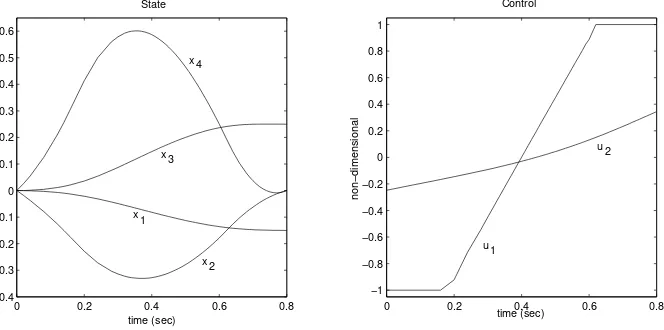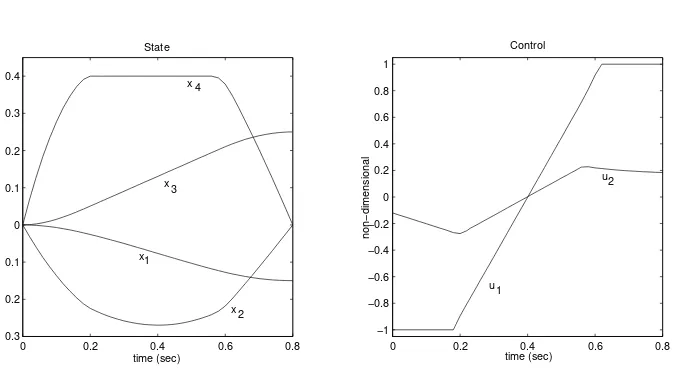Minimum-Energy Control of Two-Link
Manipulator with
Pure State Constraints
Subchan
Jurusan Matematika
Institut Teknologi Sepuluh Nopember, Surabaya
Abstract
This paper presents an analysis and numerical solutions of the minimum-energy control of two-link robot manipulator. The minimum-energy control point-to-point trajectory is investigated subject to control constraints and state constraints on the angular velocities. The numerical solutions are solved by transforming the original problem into a nonlinear programming problem. The mathematical analysis of the optimal control problems is done based on the numerical results using an indirect method. The necessary conditions can be stated as a multi-point boundary value problems.
Keywords: optimal control, minimum-energy control, direct method, indirect method, robot manipulator
1. Introduction
Robot manipulators are used for variety tasks in industry. The important performances of the robot manipulators are the speed and energy when its work. Therefore minimum energy point-to-point trajectory of two-link robot manipulators are investigated subject to
control and state constraints. The point-to-point control of multiple link manipulators can be applied to accurate aiming of an industrial robot or a multi-body spacecraft.
The methods for solving optimal control can be classified generally into two main categories: direct and indirect methods. The direct method solve the optimal control problem by discretizing the control and/or the state variables, transforming the optimal control problem into a Nonlinear Programming Problem, NLP, see eg Betts [1], Von Stryk and Bulirsch [2], Seywald and Kumar [3], while the indirect methods are based on the solving of the necessary conditions derived from the Pontryagin Maximum Principles (Pontryagin et al. [4]).
2. Optimal Control Problem
The general optimal control problem is to find an admissible controluto optimise the performance index in the following general form (Bryson and Ho [5]):
J[u] =φ[x(tf, tf)] +
Z tf
t0
L(x,u, t)dt (1)
subject to the dynamic equations, terminal conditions and boundary conditions
˙
x = f(x,u, t)
Ψ[x(tf), tf] = 0 x(t0) = 0
Here x(t) ∈ Rn, u(t) ∈ Rl, and Ψ ∈ Rk. Assume that the functionsφ, L, and
f, respectively, are continuously differentiable with respect to all their arguments. The Hamiltonian function is defined with Lagrange multipliersλ(t)∈Rnas
H =λTf +L (2)
The minimum principle requires that the controluminimiseH:
u∗
= arg min
u∈Ω H(x∗
,λ∗
,u, t) (3)
whereΩis the set of admissible piecewise continuous control values andx∗
,λ∗
, andu∗
and the Hamiltonian satisfy the following conditions:
whereνis a constant multiplier vector of the dimension of the constraintΨ. Control and state inequality constraints are augmented to the Hamiltonian, and additional necessary conditions are obtained as a result. These necessary conditions depending on the type of the state constraint.
3. Problem Formulation
We consider two-link manipulator as developed by Wie, Chuang and Sunkel [6]. The dynamic behaviour of the system is described by the following state equations,
˙
whereαis a system parameter used to denote the type of torque applied to the second link,α= 1for a joint torque andα = 0for a direct torque,I1is the mass moment of inertia of the first link with respect to the shoulder axis scaled byTmax,I2 is the mass
moment of inertia of the second link with respect to the elbow axis scaled byTmax:
I3 = I1+m2L21/Tmax
I4 = m2rL2
1/Tmax
The minimum energy problem is investigated as the performance index
minJ(u) =
subject to initial conditionsx0and final conditionsxt
The final timetf has to be prescribed in order to obtain useful solution. The control
uiare bounded as follows:
|ui(t)| ≤1, i= 1,2 (6)
The state variables are constrained by
|xi(t)| ≤ximax, i= 1, . . . ,4 (7)
3.1. Unconstrained problem
The problem is transformed into Mayer problem by introducing variablex5, where
˙
Thus the Hamiltonian for the unconstrained problem can be defined by
The controls can be derived explicitly fromHu= 0as follows:
The transversality condition (eq. [4c]) gives
λ5(tf) =
∂J
∂x5(tf)
= 1 (17)
The controluiare constrained as follows:
|ui(t)| ≤1, i= 1,2 (18)
The final timetf is fixed on 0.8 sec. Figure 1 shows thatu1is directly on the minimum
value. Then follows by unconstrained case (see Eq. [15]). Finallyu1is saturated on the maximum value. Whileu2is unconstrained along the optimal trajectory.
0 0.2 0.4 0.6 0.8
Figure 1: The computatinal results of the unconstrained case
3.2. Constrained problem
The state constraints can be written as
Consider the following equations:
∂ ∂ui
Si(1)= 0,
∂ ∂ui
Si(2)6= 0, i= 1,3 (20)
and
∂ ∂ui
Si(1)6= 0, i= 2,4 (21)
where
Si(k):=
dk
dtkSi, i= 1, . . . ,4 k= 1,2, . . . (22)
From eq. [20] and [21] we obtain that the state constraintsx1andx3are second order state constraints and the state constraintsx2andx4are first order state constraints. The Hamiltonian for constrained problem becomes
Hcons=Hf ree+η1S(2)
1 +η2S (1) 2 +η3S
(2) 3 +η4S
(1)
4 (23)
The costate equations can be derived as in the unconstrained case by considering whether the constraints active or not.
4. Numerical Example
This section presents an example for the constrained minimum-energy problem. The ini-tial conditions arex0 = [0,0,0,0]and the final conditions arextf = [−0.15,0,0.25,0].
The timetf is fixed on0.8sec andα= 1. The state constraints are|xi(t)| ≤0.4, i=
1, . . . ,4. The computational results are based on the direct collocation (DIRCOL) by Von Stryk [7].
Figure 2 shows that the state constraintx4is active while the other state constraints are not active. When the state constraintx4is active the Hamiltonian can be defined by
Hcons=Hf ree+η4S4(1) (24)
The controlu1 is saturated directly on the minimum value at the beginning . Then fol-lows by unconstrained case. Finally the controlu1is saturated on the maximum value. Furthermore the controlu2is not constrained along the optimal trajectory.
5. Conclusions
0 0.2 0.4 0.6 0.8
Figure 2: The computational results of the constrained case
The main drawback of the direct methods is that they produce several minima so-lutions and the soso-lutions are less accurate than the indirect methods. To overcome these problems it is necessary to use the direct method solutions as a starting analysis and initial guesses for the indirect methods.
The main advantage of the indirect methods is that they produce very accurate result. The major difficulties of the indirect methods are that the user must derive the costate variables, jump conditions and switching structures. It is very difficult to define where the jump conditions and switching structures should occur without knowing the direct methods solutions as a priori estimate.
References
[1] J. T. Betts. Survey of numerical methods for trajectory optimization. Journal of Guidance, Control, and Dynamics, 21(2):193–207, Mar–Apr 1998.
[2] O. von Stryk and R. Bulirsch. Direct and indirect methods for trajectory optimization. Annals of Operations Research, 37:357–373, 1992.
[3] H. Seywald and R. R. Kumar. Some recent developments in computational optimal control.IMA Volumes in Mathematics and its Applications, 93:203–234, 1997.
[5] A. E. Bryson and Y. C. Ho.Applied Optimal Control. Optimization, Estimation, and Control. Revised Printing. Hemisphere Publishing Corporation, New York, 1975.
[6] B. Wie, C-H. Huang, and J. Sunkel. Minimum-time pointing control of two-link manipulator.Journal of Guidance, Control, and Dynamics, 13(5):867–873, 1990.


